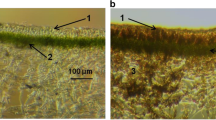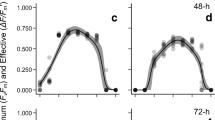Abstract
A lichen growing in a continental Antarctic region with low temperatures and strong irradiance in summer was investigated for evidence of photoinhibition. Field experiments with Umbilicaria aprina from a sheltered site with heavy snowpack showed no effects of photoinhibition when the lichen was exposed to strong sun irradiance for nearly 11 h a day. This was evident from CO2 exchange and simultaneous chlorophyll a fluorescence measurements. CO2 exchange was also not affected if quartz glass allowing greater UV penetration, was used as a lid for the cuvette. The dependency of net photosynthesis on photosynthetic photon flux density suggests that the lichen is photophilous.
Similar content being viewed by others
Author information
Authors and Affiliations
Additional information
Received: 2 April 1997 / Accepted: 11 August 1997
Rights and permissions
About this article
Cite this article
Kappen, L., Schroeter, B., Green, T. et al. Chlorophyll a fluorescence and CO2 exchange of Umbilicaria aprina under extreme light stress in the cold. Oecologia 113, 325–331 (1998). https://doi.org/10.1007/s004420050383
Issue Date:
DOI: https://doi.org/10.1007/s004420050383




